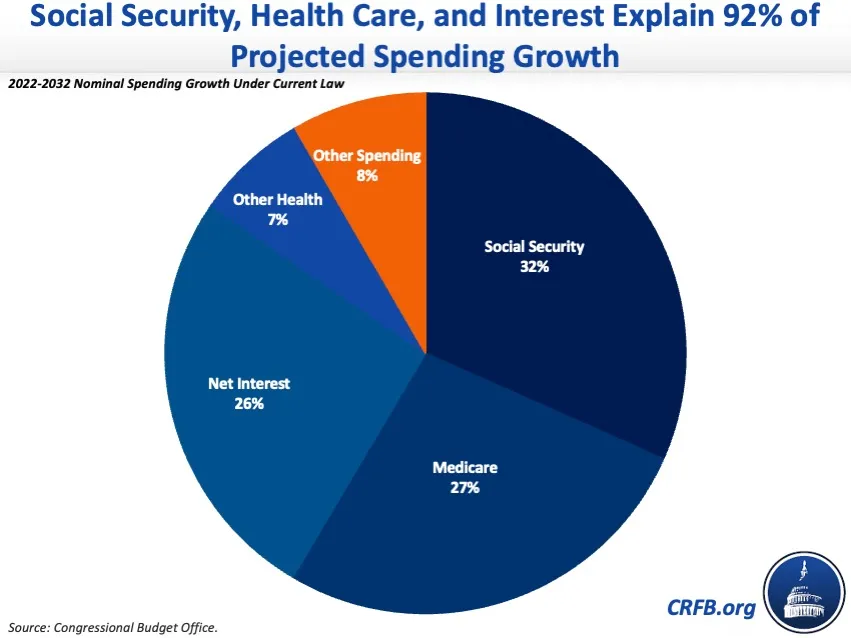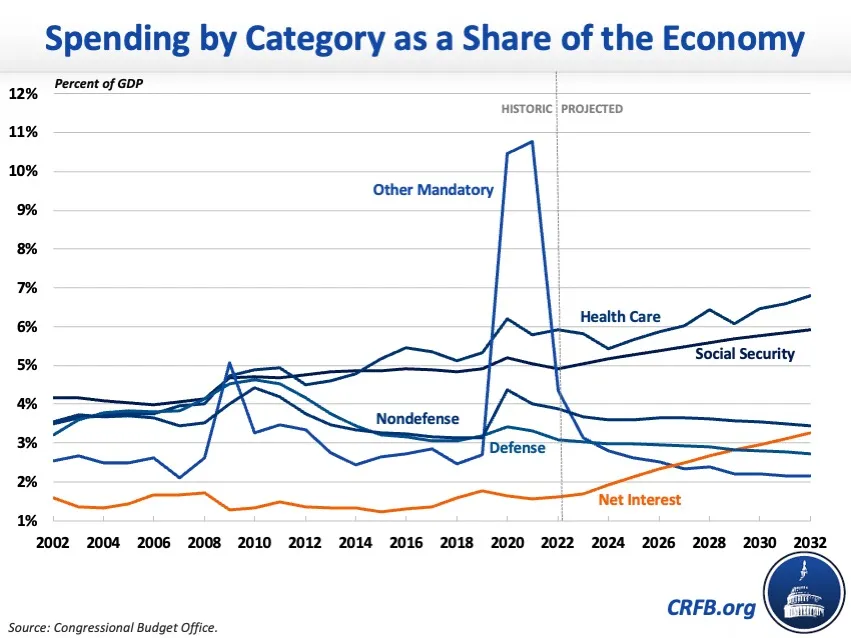92 Percent of Projected Spending Growth is from Health, Retirement, and Interest
According to the Congressional Budget Office's (CBO) latest baseline, budget deficits will rise dramatically over the next decade, from $1.0 trillion at the end of Fiscal Year (FY) 2022 to nearly $2.3 trillion by 2032. This increase is the result of a projected $3.0 trillion increase in spending over those ten years exceeding the projected $1.8 trillion increase in revenue. 92 percent of projected nominal spending growth under current law can be explained by three budget areas: Social Security, federal health care programs, and interest payments on the national debt. Even under an alternative scenario where policymakers extend most expiring tax cuts and allow annual appropriations to grow with the economy instead of inflation, those three areas would still account for 85 percent of projected nominal spending growth through 2032.
Of the projected $3.0 trillion increase in spending between FY 2022 and 2032 under current law, 32 percent is due to rising Social Security costs, 27 percent to growing Medicare costs, 7 percent to other federal health care programs (Medicaid, the Children's Health Insurance Program, and the Affordable Care Act exchanges), and 26 percent to rising interest payments on the national debt.

Meanwhile, all other spending - including defense non-defense discretionary spending, the Supplemental Nutrition Assistance Program, Supplemental Security Income, veterans' benefits, refundable tax credits, and other mandatory spending - explains only 8 percent of projected nominal spending growth through FY 2032.
It's important to note that some of the dominance of the growth in spending on health and retirement programs is due to the tapering off of COVID relief, which contributes to the projected 9 percent decline in other mandatory spending through FY 2032. At the same time, discretionary spending explains about 18 percent of projected spending growth. Using 2025 as the base year, after virtually all COVID relief is spent, rising health, retirement, and interest costs will be responsible for 83 percent of projected spending growth through 2032.
Under either metric, interest and mandatory spending - especially spending on older cohorts - are driving the projected rise in spending and the national debt. This trend becomes even more apparent when looking at these categories as a share of the economy, where spending on Social Security, health care, and interest comprise 670 percent of total projected spending growth. Under an alternative scenario where policymakers extend most expiring tax cuts and grow annual appropriations with the economy instead of inflation, spending on Social Security, health care, and interest would comprise 244 percent of total projected spending growth as a share of the economy.
Between FY 2022 and 2032, total spending will rise by 0.5 percentage points of Gross Domestic Product (GDP). Of that, Social Security will grow by one percentage point of GDP, health care spending will grow by 0.9 percentage points, and interest will increase by 1.6 percentage points. Meanwhile, CBO's baseline assumes total discretionary spending will fall by nearly one percentage point of GDP, split roughly evenly between defense and nondefense discretionary spending. Moreover, in part due to the end of COVID relief, non-health and non-interest mandatory spending will decline by 2.2 percentage points of GDP over the next decade, with nearly 80 percent of the decline happening by 2025.

The largest budgetary challenges stem from rising interest costs and the growth of our entitlement programs, the latter of which is driven by the aging of the population. This suggests policymakers should focus on slowing the growth of these areas, better funding them, or some combination.


